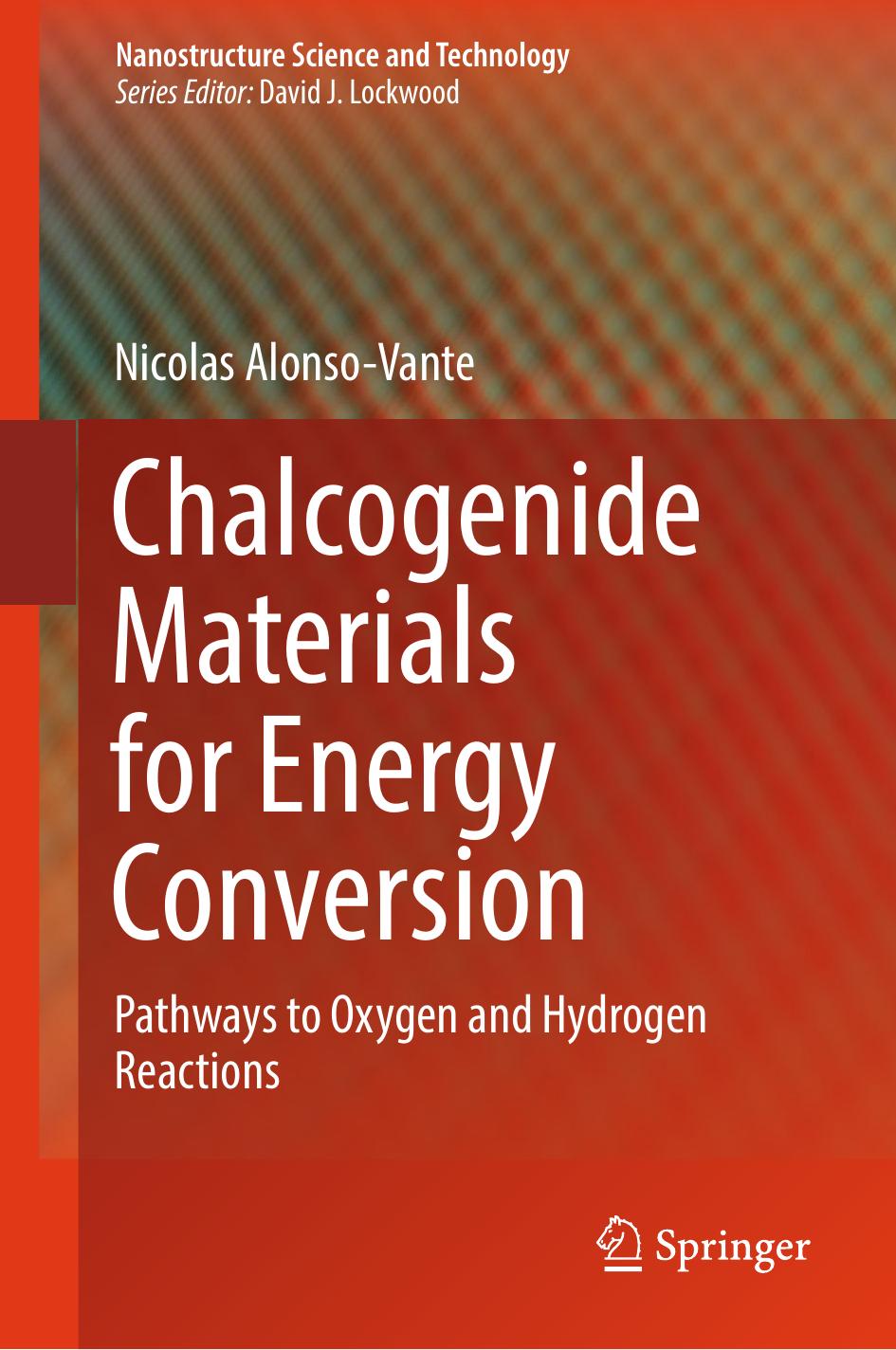Chalcogenide Materials for Energy Conversion by Nicolas Alonso-Vante

Author:Nicolas Alonso-Vante
Language: eng
Format: epub, pdf
Publisher: Springer International Publishing, Cham
A further achievement to enhance the electrocatalytic activity was done by a monolayer dendritic growth of ternary chalcogenide : WS2(1-x)Se2x. The abundant edge sites generated were evidenced by sulfurization and selenization of tungsten trioxide powders [174].
Unlike the TMD-layered materials, cf. Fig. 1.4, cobalt disulfide (CoS2) is a narrow bandgap ferromagnetic material, while the isostructural pyrite (FeS2; Eg = 0.95 eV) is a diamagnetic semiconductor , long considered as a solar energy material [203], and the low-band-gap semiconductor nickel disulfide (NiS2, Eg = 0.3 eV [204]). The pyrite structure is characterized by the presence of anions pairs X22− (X: S, Se, Te), as a consequence of the increased binding energy of the d-orbitals of the transition metal, and considered as better HER materials than bulk layered materials [205]. In this context, by a specific morphology control, Faber et al. [206] demonstrated that the HER can be tailored on metallic cobalt disulfide with different morphologies, such as films, microwire, and nanowire (Fig. 4.15a). This figure shows the current density, referred to the geometric surface area, and contrasted with the morphology (F, MW, and NW), as a function of the applied electrode potential, together with the Tafel analysis (Fig. 4.15b). By thermal sulfurization of electron-beam evaporated metal thin films previously deposited onto graphite substrates, Faber et al. prepared CoS2 and MxCo1-xS2 (M: Fe, Ni) pyrite structure compounds [50]. The HER activity of all these pyrite-phase thin films is displayed in Fig. 4.15c. The results offer a clear HER performance difference within the same pyrite structure. Cobalt disulfide achieves the cathodic current of 10 mA cm−2 at an overpotential of −0.192 V, and additional data are summarized in Table 4.6. The result on CoS2 is comparable to the best MoS2 (T-MoS2) reported so far (see Table 4.5). The Tafel plot in Fig. 4.15c discloses a similar Tafel slope, around 50−60 mV/decade. One further interesting aspect in tailoring activities among the pyrite structure is the electronic modification by introducing (alloying) CoS2 with Fe and Ni, since the HER performance of NiS2 and FeS2 is lower. Certainly, the intrinsic conductivity of the materials plays an important role since, as mentioned above, CoS2 possesses a metal-like behavior. It is also worth to mention, besides the electrocatalytic application, that the properties of making Co1-xFexS2 alloys are to raise the conductivity. Due to the alloy, low-temperature conduction electrons, tunable with x, provide fundamental investigation for the development of spintronic devices [207], and solar applications [208]. The HER electrocatalytic improvement on tungsten- and cobalt disulfide, as summarized in Table 4.6, is due to the various modifications of the catalytic center, via synthesis route, nanoalloying, and the interaction with the support .
Fig. 4.15a Current–potential characteristics on CoS2 films, MW array, and NW array electrodes for the HER electrocatalysis. Pt is also shown for comparison in H2-purged 0.5 M H2SO4 electrolyte at RT. b Tafel plot of data presented in (a). The electrode morphology is shown in the inset of (b). Figures a and b were adapted with permission from Ref. [206]. Copyright © 2014, American Chemical Society.
Download
Chalcogenide Materials for Energy Conversion by Nicolas Alonso-Vante.pdf
This site does not store any files on its server. We only index and link to content provided by other sites. Please contact the content providers to delete copyright contents if any and email us, we'll remove relevant links or contents immediately.
| Automotive | Engineering |
| Transportation |
Whiskies Galore by Ian Buxton(40334)
Introduction to Aircraft Design (Cambridge Aerospace Series) by John P. Fielding(32338)
Small Unmanned Fixed-wing Aircraft Design by Andrew J. Keane Andras Sobester James P. Scanlan & András Sóbester & James P. Scanlan(32141)
Craft Beer for the Homebrewer by Michael Agnew(17447)
Turbulence by E. J. Noyes(7041)
The Complete Stick Figure Physics Tutorials by Allen Sarah(6640)
Kaplan MCAT General Chemistry Review by Kaplan(6054)
The Thirst by Nesbo Jo(5786)
Bad Blood by John Carreyrou(5770)
Learning SQL by Alan Beaulieu(5412)
Weapons of Math Destruction by Cathy O'Neil(5038)
Man-made Catastrophes and Risk Information Concealment by Dmitry Chernov & Didier Sornette(4738)
iGen by Jean M. Twenge(4702)
Digital Minimalism by Cal Newport;(4545)
Life 3.0: Being Human in the Age of Artificial Intelligence by Tegmark Max(4509)
Audition by Ryu Murakami(4099)
1,001 ASVAB Practice Questions For Dummies by Powers Rod(4040)
Electronic Devices & Circuits by Jacob Millman & Christos C. Halkias(4029)
Pale Blue Dot by Carl Sagan(4003)
